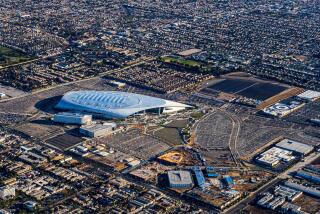New Noise Study of Van Nuys Airport Raises More Debate : Neighborhoods: A computerized map shows a larger number of residents affected than previously thought. Airport defenders counter with a favorable poll.
- Share via
A new computer projection of the impact of noise from Van Nuys Airport indicates that nearly twice as many people as previously thought live in areas where the roar of airplanes exceeds state and federal standards.
The new noise study, done at the direction of the Federal Aviation Administration, has rekindled a decade-long debate over increasing private jet use at the airport.
Homeowner group leaders are saying the study proves that airport officials long have understated the amount of noise generated by the airport. However, airport defenders, including Los Angeles Department of Airport officials, say there is no reason to give the latest results more weight than previous studies.
Airport defenders also point to the results of a telephone survey released several weeks ago, indicating that only 12% of residents in a wide swath of the San Fernando Valley find the airport a nuisance.
Both the phone survey and the noise study were done as part of a $275,000 federally funded review, called a Part 150 study, to determine ways the airport can improve relations with its neighbors.
Since release of the new data last month, both critics and defenders of the airport have been poring over charts and maps to buttress their arguments.
Homeowner leaders who contend the airport is a nuisance were heartened by the new noise projection, although they dispute the telephone survey as slanted in favor of a favorable response to the airport.
The FAA-approved map indicates that noise exceeds state and federal standards on 147 acres with 3,730 residents. In contrast, a map released six months ago by the Department of Airports showed that only 62 acres with 1,948 residents were affected by excessive noise.
Airport Manager Charles Zeman said: “The two maps were drawn using quite different methodologies, and I don’t think you can say one is necessarily better than the other. They’re just different.”
Zeman said the telephone survey “would seem to tell a lot more about the impact of the airport in the Valley, and there the results were quite favorable to the airport.”
But Gerald A. Silver, president of Homeowners of Encino, said the new noise projection map “showed what we have suspected for a long time--that the airport’s reports have distorted the impact of noise from that airport.”
As for the telephone survey, Don Schultz, president of Van Nuys-based Ban Airport Noise, said it was “taken over such a wide area that of course a majority of people say they aren’t bothered. It was fixed from the outset to tell the airport what it wanted to hear.”
Federal and state noise standards for airports are the same, but they use different methods to measure noise.
At Van Nuys, the federal noise study was accomplished by taking control tower information on each plane that landed and took off during the study period. Then, using a computer, the resulting noise impact was projected on a map of the surrounding neighborhood.
The key projection is a line encompassing all areas that experience average noise levels exceeding federal and state standards.
For more than a decade, airport officials have been compiling similar maps, but the data is gathered largely by recordings of noise registered by four microphones permanently installed north and south of the runways.
Airport officials say the use of microphones is mandated by the state, which permits Van Nuys and most other airports in California to continue operating while generating noise in excess of state standards.
In April, 1989, Van Nuys Airport was given a three-year noise variance to continue operating in excess of noise standards, provided the size of the excessive-noise area did not increase.
Since the state variance was based on the state-mandated method of measuring noise, the new FAA noise map “should have no effect on our operating variance,” Zeman said.
Maurice Z. Laham, Department of Airports environmental manager, contended that both the state and federal methods have their merits. “Microphones aren’t always accurate,” he said, “but on the other hand, a computer projection doesn’t take into account how much an individual pilot can vary noise by controlling the power used in takeoff and so on.”
In the telephone survey, 505 residents--from a wide area roughly bounded by Woodman and Corbin avenues, Mulholland Drive and the Santa Susana Mountains--were asked for their opinions of the airport.
Of those, 88% said they were indifferent to airport operations or viewed the airport favorably. Only 12% said they viewed the airport unfavorably.
But Schultz said that the poll, devised by a consultant to the Department of Airports, was “drawn in such a way that you knew what the answer would be.”
He contends that only 184 of the respondents live in areas with ZIP codes where they are likely to experience much airport noise.
More than 40% of those interviewed who live in areas with ZIP codes south and immediately east and west of the airport indicated they viewed the airport unfavorably, he noted.
“Those are the people who live with the airport,” he said. “The ones who experience it every day. They are the people you should ask about airport noise.”
More to Read
Sign up for Essential California
The most important California stories and recommendations in your inbox every morning.
You may occasionally receive promotional content from the Los Angeles Times.










